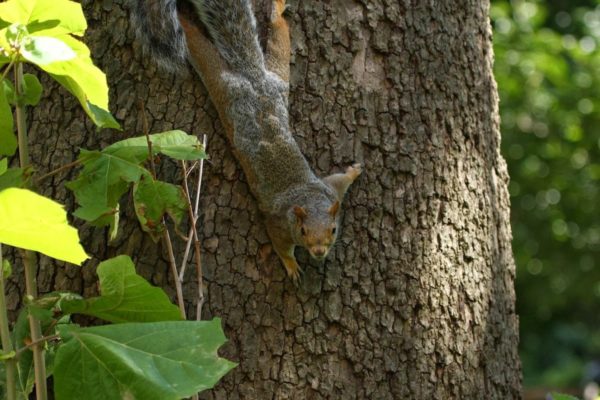I didn’t see Rosie or Bobby Hawk when I visited Washington Square Park on Tuesday the 24th or today. I searched for them for about an hour and a half each day.
I got ‘yelled’ at by a squirrel when I stopped by its tree to compose a text message on my phone:
I saw a rat drinking from a tub of water left for the squirrels:
I have seen rats drink from the squirrel water before but I think this was the first time I caught one in the act. The sight brought to mind the phrase, “Feed (water) a squirrel, breed a rat”. Pigeons drink from the tubs as well.
What looks like droppings on the rock in the foreground:
This particular tree is at the northwestern corner of the park. There are two regular squirrel feeders who I’ve seen place peanuts in the grooves of this and other trees’ bark.
There is little doubt that the rats access the peanuts and other foodstuffs left out for the pigeons and squirrels throughout the park and it is the feeding of these creatures, as well as the failure of the Parks Department to control the park litter, that propagates the rat problem.
As I’ve mentioned before, there are now signs at the park entrances that read, “Do Not Feed Pigeons” but people continue to do so and I’ve never seen anyone given a citation or reprimanded verbally about it.
If Parks were to enforce its rules by issuing citations to pigeon feeders (it’s not against Park rules to feed squirrels as far as I know) and litterers, there would be a double benefit; the money spent to pay maintainance workers to clean the park would be largely recouped and the amount of litter itself would be significantly reduced. The happy outcome would be that the public would have a cleaner and healthier park to enjoy, there would be less rats to deal with, and there would ultimately be a reduced threat to the lives of the resident Red-tailed Hawks.
I received the Parks Department response below to my email regarding the rodenticide in Washington Square Park’s rat traps. All I will say at the moment in response is that as it stands now, Bobby and Rosie are truly in danger of dying from eating a rat poisoned from the rodenticide Bromadiolone that is now confirmed to be in the traps.
As I have written in this post, Bromadiolone is a dangerous anticoagulant rodenticide and was the principal poison that killed Pale Male’s mate Lima in 2012 (link to the New York State Department of Environmental Conservation necropsy of Lima here). The Parks Department response to my email is below.
***
Thank you for your inquiry about pest control techniques in Washington Square Park.
The New York City Parks Department uses an Integrated Pest Management approach to rodent control. We bait our sites with rodenticide when necessary, but we also focus on identifying and correcting any conditions within a park that attract rodents such as litter, garbage pickup, and illegal feeding of birds and squirrels. Sanitation is our principal form of pest control and we also need the public’s help in maintaining litter-free parks.
If a rodent infestation becomes moderate or heavy, we also bait the park. Our baiting is performed by pesticide technicians who are licensed by New York State. To combat the drastic increase in rats in Washington Square Park, we have decided that baiting in conjunction with controlling food sources is the best course of action to prevent the rodent population from further multiplying. At Washington Square Park and our other parks we use bromadiolone, an anticoagulant which is categorized as a low to moderate primary risk to birds, and as a moderate secondary risk to birds.
We are attentive to wildlife issues in parks and change rodent control methods accordingly.
When we see a breeding pair of hawks inside a park or in close proximity to one, we suspend all baiting from the beginning to the end of fledgling season. Fledgling season usually begins in February when breeding hawks begin to build their nest. We then suspend baiting until after the young hawks fledge the nest in late August. This year we resumed baiting in mid-September.
We strive to maintain a balance between the needs and interests of all park users, while maintaining a healthy environment for everyone.



